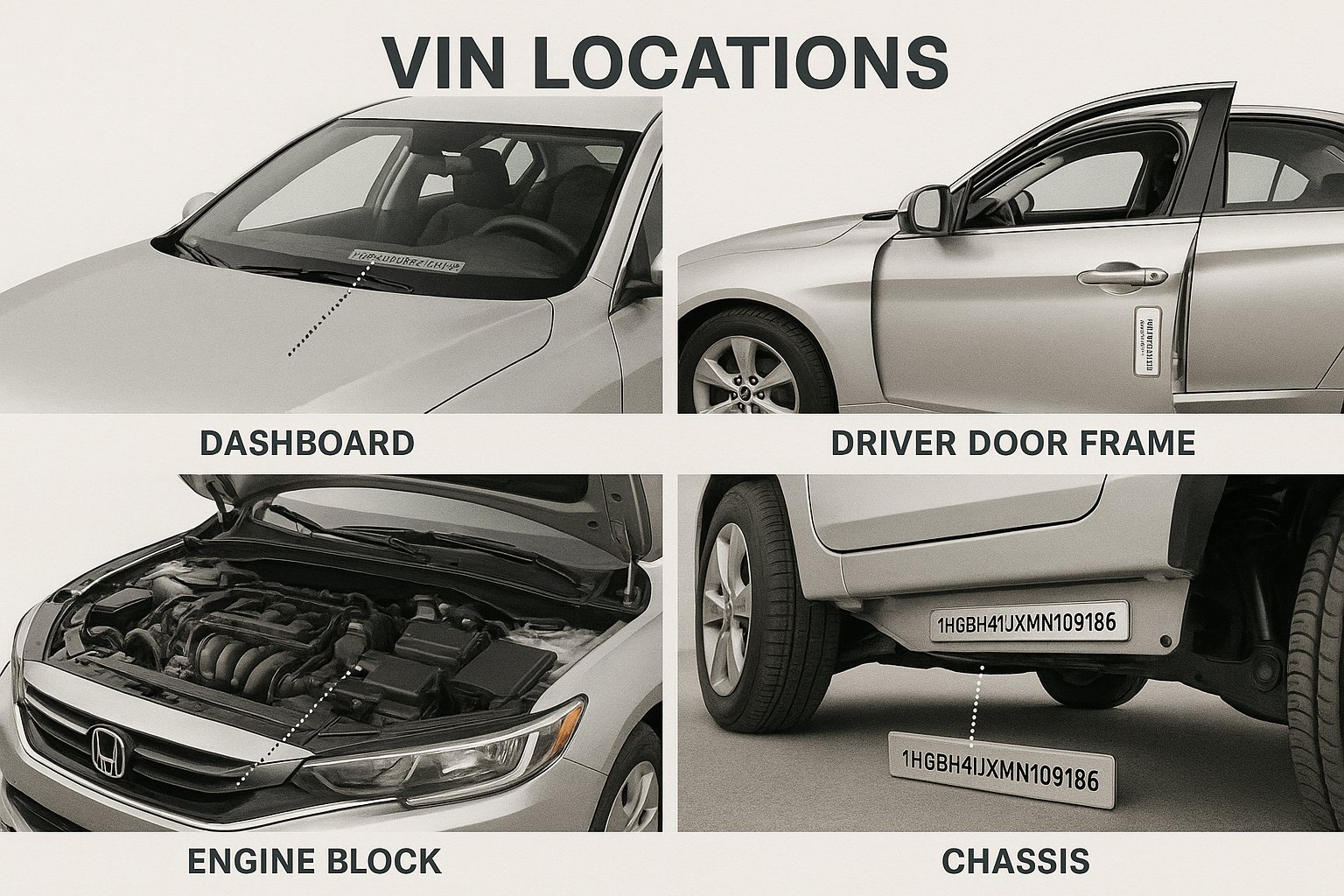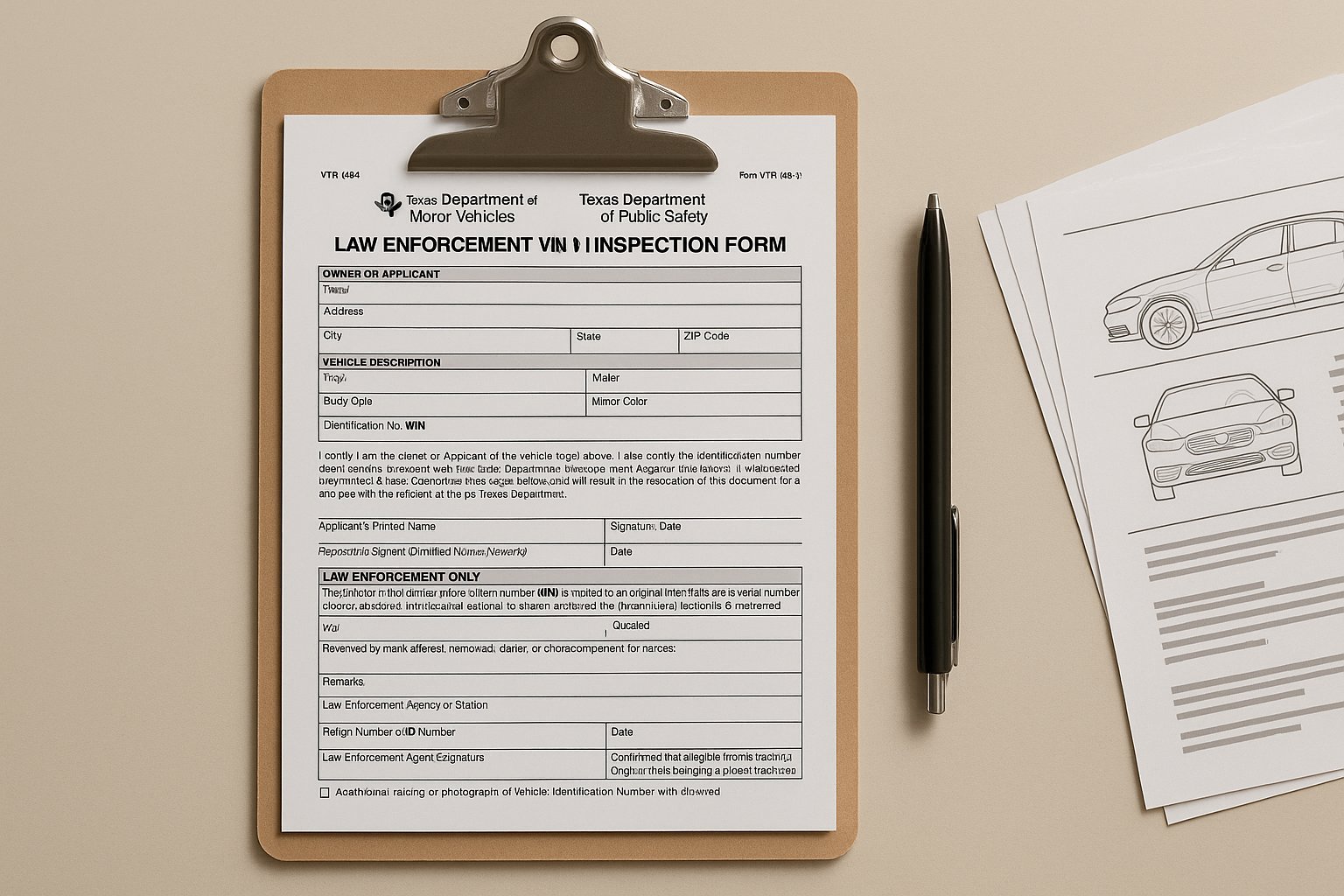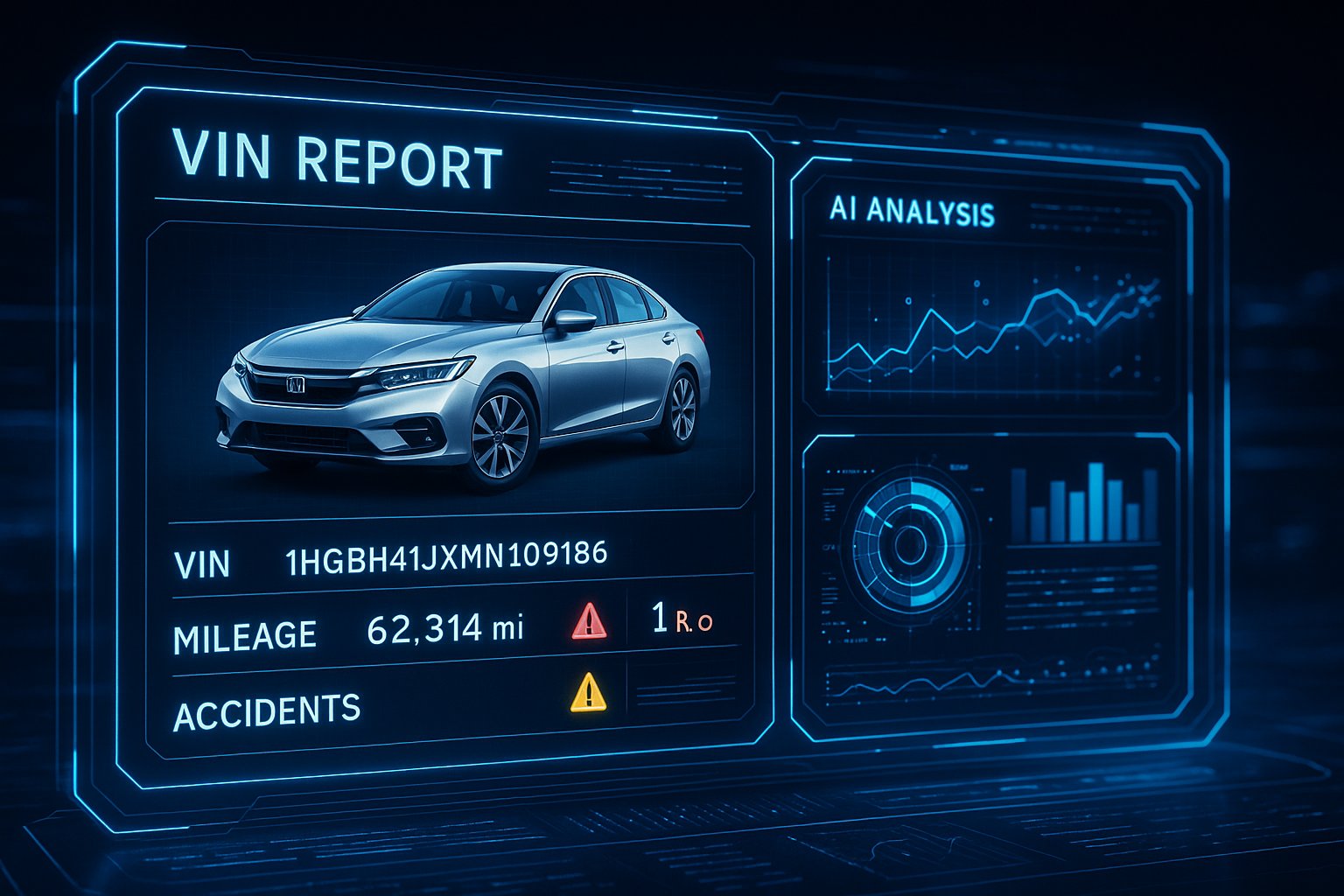
Texas VIN Check – Complete Guide to VIN Lookup, Inspection & Reports
If you’re thinking about buying a used car in Texas, the very first thing you should do is perform a Texas VIN check.
It’s the most effective and reliable way to uncover a vehicle’s real history before you pay for it.
With a VIN check Texas, you can find out whether a car has ever been in an accident, declared salvage, had its mileage rolled back, been flooded, stolen, or rebuilt after major damage.
This detailed guide explains everything you need to know about checking a VIN number in Texas, including free lookup options, state inspection procedures, forms like VTR-68A, and how advanced tools such as VINspectorAI can help you detect hidden risks before you buy.
What Is a VIN and Why It’s Important
A VIN (Vehicle Identification Number) is a unique 17-character alphanumeric code that serves as your vehicle’s permanent identity — assigned by the manufacturer at the time of production.
Think of it as your car’s digital fingerprint: every car, truck, or motorcycle in the world has its own VIN, and no two are ever the same.
Each character in the VIN provides specific details about the vehicle’s origin and design. The VIN is structured according to an international standard (ISO 3779), ensuring every country and manufacturer follows the same format.
Here’s what a VIN reveals about your car:
World Manufacturer Identifier (WMI): The first three characters show the country of origin and manufacturer. For example, “1” or “4” indicates the U.S., “2” is Canada, “3” is Mexico, “J” is Japan, and “W” is Germany.
Vehicle Descriptor Section (VDS): Characters 4–9 describe the model, body type, engine type, restraint system, and other major specifications.
Vehicle Identifier Section (VIS): The last eight characters include the model year, assembly plant, and production sequence number unique to that specific unit.
Check Digit (the 9th character): This is a mathematical formula that confirms the VIN’s validity and helps prevent fraud or typing errors.
Because a VIN encodes all this information, it’s used as a central identifier in every step of a vehicle’s lifecycle — from factory production to final resale or scrapping.
In Texas, and throughout the United States, the VIN number plays a vital role in:
Registration and titling: The Texas Department of Motor Vehicles (TxDMV) uses the VIN to issue and verify all titles and ownership transfers.
Insurance coverage: Every insurer identifies and tracks vehicles using VINs to assess risk and determine policy details.
Recalls and safety compliance: The NHTSA and manufacturers use VINs to notify owners of critical recalls or safety issues.
Law enforcement and inspections: The VIN allows police and inspectors to detect stolen or cloned vehicles, and it’s the foundation for any VIN verification or VIN inspection in Texas.
Performing a Texas VIN check is therefore essential for anyone buying, selling, or registering a used car.
It’s the only way to uncover fraud, hidden damage, odometer rollback, flood history, or title washing — a tactic where sellers re-register a “salvage” car in another state to hide its damaged history.
Where to Find the VIN Number on a Car

Before checking, make sure you have the correct VIN.
It’s printed or engraved in multiple spots on the vehicle to prevent fraud. Here are the main locations:
Dashboard (Visible Through the Windshield) – Look on the driver’s side of the dashboard, near where the windshield meets it.
Driver’s Door Frame – On a metal plate or sticker near the door latch.
Engine Block – Usually engraved near the front or side of the engine.
Vehicle Frame – Common for trucks, SUVs, and commercial vehicles.
Official Documents – On the title, registration, insurance, and inspection certificate.
Always make sure the VIN matches across all these locations.
Any discrepancy could signal tampering, theft, or that the car was illegally rebuilt.
How to Perform a Texas VIN Check — Step by Step
A complete VIN verification in Texas can be done in several ways, depending on how much detail you need and whether you’re buying from within the state or importing a vehicle.
Step 1: Run a Free VIN Check (Basic Screening)
If you want to start with a Texas VIN search free, there are a few trustworthy databases that offer basic public records:
NICB VINCheck – A free national database that reveals whether a vehicle has been reported as stolen or declared a total loss by insurance companies.
NHTSA VIN Decoder – The official federal database showing factory specifications, recalls, and production details for your VIN.
These free lookups are great for initial screening, but they won’t show the full picture.
They don’t include accident history, maintenance, title changes, odometer readings, or flood damage.
Still, they can instantly flag serious issues like theft or salvage titles — giving you a first layer of protection.
Step 2: Get a Full Report (NMVTIS Data + Advanced Analysis)
For a deeper and more reliable look into a vehicle’s past, you’ll need a comprehensive Texas VIN report from a provider connected to NMVTIS (National Motor Vehicle Title Information System) — the federal system that aggregates data from all U.S. states, insurance companies, and auto recyclers.
A full VIN check report includes:
Title history across states (Clean, Salvage, Rebuilt, Flood, Junk, etc.)
Reported accidents and insurance claims
Historical mileage readings to detect odometer rollback
Flood or fire damage records
Recall and manufacturer defect notices
Usage history (rental, taxi, fleet, or personal)
Platforms like VINspectorAI go a step further by combining NMVTIS and NHTSA data with AI-powered risk analysis, flagging unusual patterns such as repeated title transfers, frequent repairs, or mismatched odometer data.
Step 3: Physical Verification — Texas VIN Inspection

In some cases, Texas law requires a VIN inspection by an authorized agency or inspector.
You’ll need this when:
Registering a vehicle from another state or country;
Applying for a bonded, rebuilt, or salvage title;
The VIN appears altered, incomplete, or inconsistent;
You’re assigning or re-issuing a VIN after reconstruction.
In such cases, you must obtain and complete the VTR-68A form — the official Law Enforcement VIN Inspection Form used by the Texas Department of Motor Vehicles (TxDMV).
It’s typically performed at a sheriff’s office, police department, or by an inspector authorized by the Texas Department of Public Safety (DPS).
Official VIN Forms Used in Texas
Here are the most common VIN-related forms you might need during vehicle registration, title transfer, or VIN inspection in Texas — along with direct download links from the official Texas Department of Motor Vehicles (TxDMV) website:
Form | Form Name & Purpose | Download Link |
|---|---|---|
VTR-68A | Law Enforcement VIN Inspection Form — required for vehicles that are rebuilt, salvaged, imported, or have altered/missing VINs. It must be completed by a certified law enforcement officer or authorized inspector before applying for a Texas title. | |
VTR-270 | VIN Self-Certification Form — used when an inspection isn’t required, but proof of VIN ownership or confirmation is needed during registration or title transfer. | |
VTR-272 | Application for Assigned or Reassigned Number (Assigned VIN Application) — used when a vehicle has lost its original VIN plate, was reconstructed, or assembled from multiple parts and requires a new VIN issued by TxDMV. |
💡 Tip: Always download the latest version of these forms directly from the official TxDMV website — older copies may be rejected. Make sure to print them in black ink and fill out all required fields clearly.
All forms must be completed accurately and submitted with any supporting documents (title, bill of sale, inspection report).
Submitting incorrect or incomplete information can delay or even block your Texas title or VIN assignment process.
Important Law Update — Texas Vehicle Inspections (2025)

As of January 1, 2025, Texas has eliminated the mandatory annual safety inspection for most non-commercial vehicles.
However, VIN verification and emissions tests remain mandatory in specific counties such as Dallas, Harris, Travis, Bexar, and others.
So even if your vehicle no longer needs a safety inspection, you may still be required to:
Verify your VIN through an official inspection (VTR-68A) when titling or registering;
Complete emissions testing in counties where air quality standards apply;
Submit proof of VIN inspection when applying for a rebuilt, salvage, or bonded title.
These changes aim to simplify registration but still ensure that VIN identity verification prevents stolen or fraudulent vehicles from entering the Texas system.
How to Interpret a VIN Report — What to Watch Out For

A VIN report isn’t just a list of data — it’s the complete story of a car’s life.
Here are the most important sections to check:
1. Title Status
Look for the current and historical titles. Common types include:
Clean Title – No major damage or total-loss reports.
Salvage Title – The car was declared a total loss by insurance.
Rebuilt Title – The vehicle was repaired and re-certified after being salvaged.
Flood, Fire, or Hail Damage – Indicates environmental destruction.
A good Texas VIN check will clearly identify these statuses and the state where they were issued.
2. Mileage History
Check for consistent mileage increases. If you see the numbers going down over time, that’s a sign of odometer rollback — one of the most common types of auto fraud.
3. Accident and Damage Records
Detailed reports will show if a vehicle suffered structural, frame, or airbag damage.
Repeated accidents or multiple repair entries in a short time should be treated as red flags.
4. Multi-State Registrations
Cars that frequently move between states might have been re-titled to hide damage or salvage status — a tactic known as title washing.
A complete Texas VIN verification can reveal those patterns instantly.
Using the VIN Report During the Buying Process
Once you have your VIN check Texas report, use it strategically before closing the deal:
Review all data carefully — look for inconsistencies between the title, mileage, and repair records.
Identify risk factors — flood history, salvage titles, or odometer discrepancies.
Compare with the listing — if the seller claims “accident-free” but the report says otherwise, question their honesty.
Request supporting documents — legitimate sellers will show maintenance receipts or insurance paperwork.
Use the report in negotiations — you can lower the price or walk away if the risks are too high.
A VIN report isn’t just information — it’s your best leverage for making a safe, smart purchase.
Why Choose VINspectorAI for Your Texas VIN Check

While traditional VIN check services simply list data, VINspectorAI uses artificial intelligence to interpret it for you.
Here’s what makes it stand out:
Aggregates official NMVTIS, NICB, and NHTSA data;
Applies AI-driven risk analysis to detect unusual VIN patterns;
Flags potential fraud indicators, such as odometer rollbacks or suspicious title transfers;
Displays results in a clear, visual dashboard;
Allows multiple VIN comparisons (ideal for dealers and fleet owners).
In short, VINspectorAI transforms raw data into actionable insight, helping Texas car buyers make confident, data-backed decisions.
Final Checklist Before Buying a Used Car in Texas
Buying a pre-owned vehicle in Texas requires more than just checking the price and mileage — it’s about verifying the car’s true identity and condition.
Use this comprehensive VIN checklist to make sure every step of your purchase is safe, legal, and fully documented.
Step | Action & Explanation |
|---|---|
✅ 1. Verify the VIN number on the vehicle and documents | Check that the VIN on the dashboard, door frame, engine, and all official documents match exactly. Any mismatch could mean tampering or fraud. |
✅ 2. Run a free Texas VIN search | Use NICB VINCheck to see if the car was stolen or declared salvage, and NHTSA VIN Decoder for recalls and manufacturing data. |
✅ 3. Order a full VIN report | Get a complete NMVTIS-approved VIN report from a trusted provider like VINspectorAI. It shows title history, accidents, mileage, and flood records. |
✅ 4. Compare the title and mileage history | Ensure the mileage increases logically over time. Sudden drops can indicate odometer rollback or data manipulation. |
✅ 5. Check for open recalls | Run the VIN through the NHTSA recall database or manufacturer website to confirm all recalls have been fixed. |
✅ 6. Complete a VIN inspection (VTR-68A) if required | Vehicles imported, rebuilt, or with VIN discrepancies must go through an official Texas VIN inspection using Form VTR-68A. |
✅ 7. Have a mechanic perform a full inspection | Even if the VIN report looks clean, have a certified mechanic check the vehicle for leaks, rust, or frame damage. |
✅ 8. Use your VIN report to negotiate | A complete VINspectorAI report gives you negotiation power. If you find issues, you can lower the price or walk away safely. |
Expert Tips for Buyers in Texas
Always confirm the seller’s identity matches the name on the title.
Avoid cars with salvage titles unless you have verified repairs and VTR-68A clearance.
Keep printed copies of your VIN report and inspection forms — they protect you during registration.
Use the VINspectorAI dashboard to store, compare, and analyze multiple reports if you’re shopping for several cars.
Conclusion
Buying a used car in Texas can be safe and rewarding — but only if you verify before you buy.
A thorough Texas VIN check gives you the full picture: title history, accidents, mileage, recalls, and hidden risks.
Before you pay, verify.
Before you sign, analyze.
Whether you start with a free VIN lookup or a full AI-powered VINspectorAI report, you’ll know exactly what you’re getting.
Transparency means security — and in the Texas used car market, a VIN check is the smartest investment you can make before turning the key.
Frequently Asked Questions
Get answers to common questions about Texas VIN Check – Complete Guide to VIN Lookup, Inspection & Reports
Uncover Complete Vehicle History Reports
Discover critical vehicle information before you buy. Our VIN decoder reveals accident records, title status, recalls, and service history to help you make informed decisions.
Related Articles
No related articles found